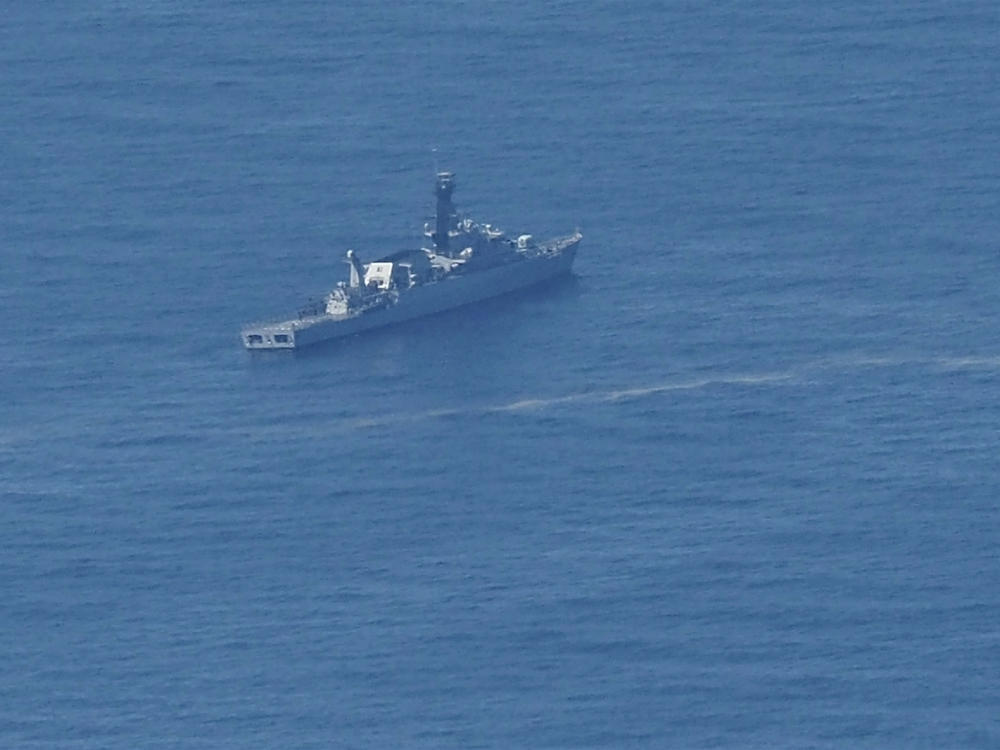Section Branding
Header Content
Time Running Out To Rescue 53 Sailors Aboard Missing Indonesian Submarine
Primary Content
Rescuers scouring the Bali Sea for a stricken Indonesian submarine with 53 sailors aboard are hoping the crew could still be alive, but as the hours since the vessel's disappearance tick by, the chances of survival grow increasingly slim.
The Indonesian navy chief of staff, Adm. Yudo Margono, told reporters Thursday that a search of the vicinity where the diesel-powered KRI Nanggala 402 is believed to have gone down, about 60 miles north of the resort island of Bali, had located an object with "high magnetic force" floating at a depth of 50 to 100 meters (about 165 to 330 feet). "We hope it is the KRI Nanggala," he said.
But the navy had said previously that it believes the submarine may have sunk in a particularly deep spot in the otherwise relatively shallow sea — about 600-700 meters (2,000-2,300 feet) down — much deeper than the boat's maximum operating depth and likely below its crush depth.
Even in a best case scenario, the navy chief of staff emphasized that with oxygen expected to run out early Saturday a quick rescue would be critical. "Hopefully we can rescue them before the oxygen has run out," he said.
The KRI Nanggala was conducting a weapons training exercise early Wednesday when the navy said the sub was given permission to dive and then never made radio contact again.
Earlier, rescuers reported finding an oil slick on the surface and the smell of diesel fuel, but there was no way of knowing whether it came from the sub. While an oil slick might be a sign that the vessel was destroyed, the navy said it could simply mean that the submarine's fuel tank had been damaged. It could even be a deliberate signal from the crew.
Indonesian President Joko Widodo said Thursday that he had ordered an "optimal" search for the submarine and that the rescue of its crew was the "main priority." He expressed sympathy with family members over their ordeal.
The German-built submarine has been in service since the early 1980s. Despite its age, a refit of the vessel by South Korea's Daewoo Shipbuilding and Marine Engineering was completed in 2012. A Daewoo official told The Associated Press that the company had upgraded the boat's internal structures and systems.
Speaking to reporters, the navy chief of staff said the submarine had "received a letter of feasibility from the navy" and that "it was ready for battle."
Navy spokesman Julius Widjojono told Indonesia's KompasTV earlier that the boat could sustain a depth of 250-500 meters (about 820-1,640 feet). "Anything more than that can be pretty fatal, dangerous," he said.
A Daewoo Shipbuilding official, Ahn Guk-hyeon, told the AP that the submarine would collapse if it goes deeper than about 200 meters (about 655 feet).
If the vessel is intact, it could be too deep for a rescue, said Frank Owen, secretary of the Submarine Institute of Australia.
"Most rescue systems are really only rated to about 600 meters (1,969 feet)," he told the AP. "They can go deeper than that because they will have a safety margin built into the design, but the pumps and other systems that are associated with that may not have the capacity to operate. So they can survive at that depth, but not necessarily operate."
He said the Indonesian sub was not fitted with a special hatch seal that would allow the crew to escape into a different vessel during an underwater rescue.
"So the only system they have is to get to the surface and abandon the submarine on the surface; or if they're in water that is less than 180 metres [590 feet] in depth they could put a special suit on so they can breathe and not burst their lungs and they can get to the surface," Owen told The Sydney Morning Herald.
"It's still risky but it's doable," Owen said.
The Indonesian military said Thursday that at least 20 navy ships, two submarines and five aircraft have been searching the area and that a hydro-oceanographic survey ship equipped with underwater detection equipment was also on its way to the area of the oil slick.
Australia, South Korea, the United States, Germany, France, Russia, India and Turkey have all offered to assist in the search for the submarine and a possible rescue, the Indonesian navy said.
Vessels from Singapore and Malaysia are also reportedly joining in the search but won't be able to reach the area until the weekend.
Copyright 2021 NPR. To see more, visit https://www.npr.org.

